
A Guide to ADA Compliance for Hotels and Event Venues
The passage of the Americans with Disabilities Act (ADA) on July 26, 1990, was a watershed event in the story of American civil rights legislation.
The Act made the strongest possible defense of more than 20% of the American population with disabilities and backed that statement up with action.
Because business must comply with these new regulations under the threat of penalty, the ADA enables previously ignored Americans access to public spaces, thereby protecting the right of Americans with numerous disabilities, including persons with:
- Blindness Or Impaired Vision
- Deafness Or Hearing Loss
- Intellectual Disabilities
- Missing Or Partially Missing Limbs
- Mobility Impairments
- Autism
- Cancer
- Diabetes
- Epilepsy
- Cerebral Palsy
- HIV
- Multiple Sclerosis
- Major Depressive Disorder
- Bipolar Disorder
- Schizophrenia
- Obsessive-Compulsive Disorder
- Post-traumatic Stress Disorder
Failure to comply with ADA mandates on accessibility can result in expensive lawsuits and stiff penalties. For hotels and venues, this includes obvious mandates on maintaining accessible premises, with equal access to rooms, amenities, and facilities.
For many years after 1990, most instances of litigation and enforcement under the ADA focused on the physical premises that posed obstacles to people with disabilities.
But in 2012 the US Department of Justice (DOJ) clarified that the 1991 Standards for Accessible Design (updated in 2010) applies to all public concessions of companies covered by Title I and Title III, including websites and mobile apps. The US 9th Circuit Court of Appeals’ 2019 ruling in Robles v. Domino's Pizza added Federal judicial approval to this interpretation.
In light of these developments, hotels and event venues must reckon with the fact that ADA compliance applies to:
- Physical premises
- Websites
- Mobile apps
- Reservation systems
- Any other system on the property a customer or patron might encounter.
Why You Need to Be ADA Compliant
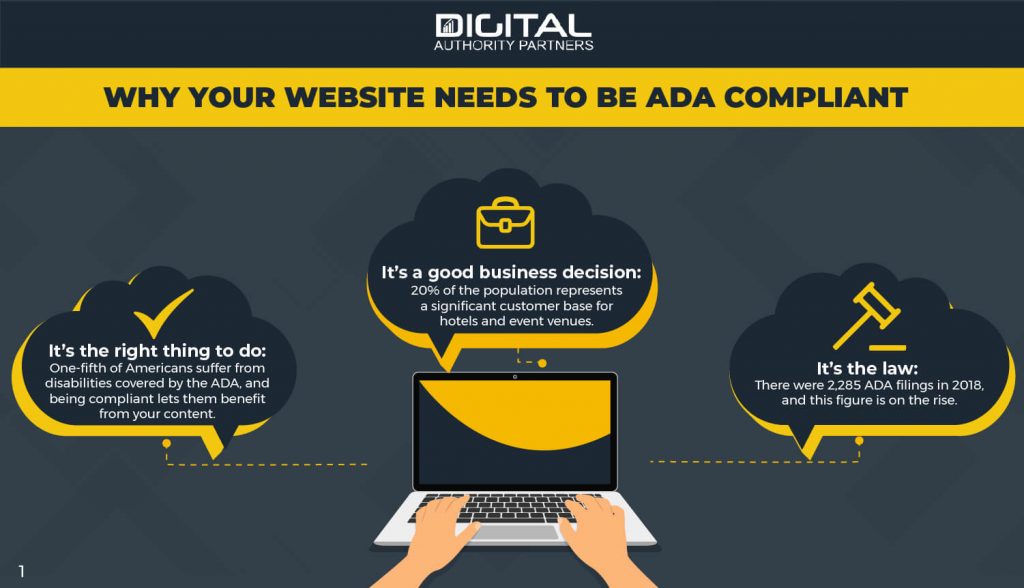
The most important reason to take ADA compliance seriously is because it is the right thing to do. One fifth of all Americans suffer from a disability covered by the ADA.
The movement for disabled rights has its origins in the postwar era when many disabled veterans who had served with honor found themselves shut out of public spaces. At its best, the ADA exists to level the playing field for a substantial constituency.
It’s also a good business decision. At 20% of the population, disabled persons represent a significant potential customer base for businesses like hotels and event venues.
Even if it weren’t good business or good citizenship, it’s also the law. ADA lawsuits tipped the scales at 2,285 filings in 2018, up 171% from the previous year and up over 20 times from 2015. Penalties assessed against ADA violators average $75,000 for a first offense.
[bctt tweet="ADA lawsuits tipped the scales at 2,285 filings in 2018, up 171% from the previous year and up over 20 times from 2015." via="no"]
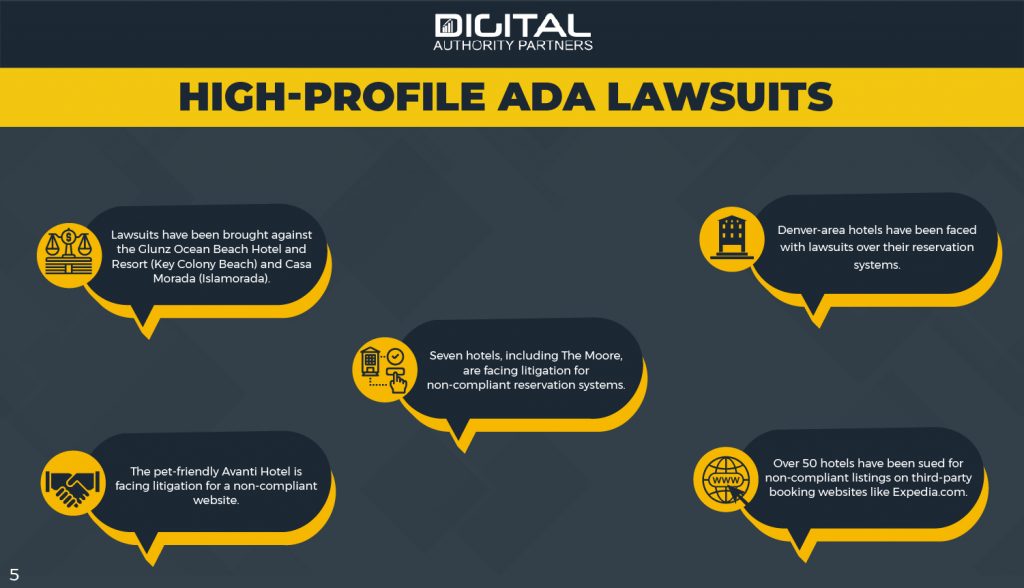
Examples of closed or active litigations against hotels for non-compliance with ADA include:
- Florida Keys—lawsuits against the Glunz Ocean Beach Hotel and Resort (Key Colony Beach) and Casa Morada (Islamorada) brought by an Ft. Lauderdale woman who has reached settlements with at least 20 other hotels.
- Palm Springs, CA—boutique, pet-friendly Avanti Hotel, facing litigation for a non-compliant website.
- Seattle, WA—seven hotels, including The Moore, The Mayflower Park Hotel, and Sorrento Hotel, facing litigation for non-compliant reservation systems.
- Denver, CO—lawsuits filed in the US District Court of Arizona by an Arizona woman against Denver-area hotels over their reservation systems.
- Georgia—over 50 hotels sued for non-compliant listings on third-party booking websites like Expedia.com or Hotels.com.
How to Tell If You’re ADA Compliant
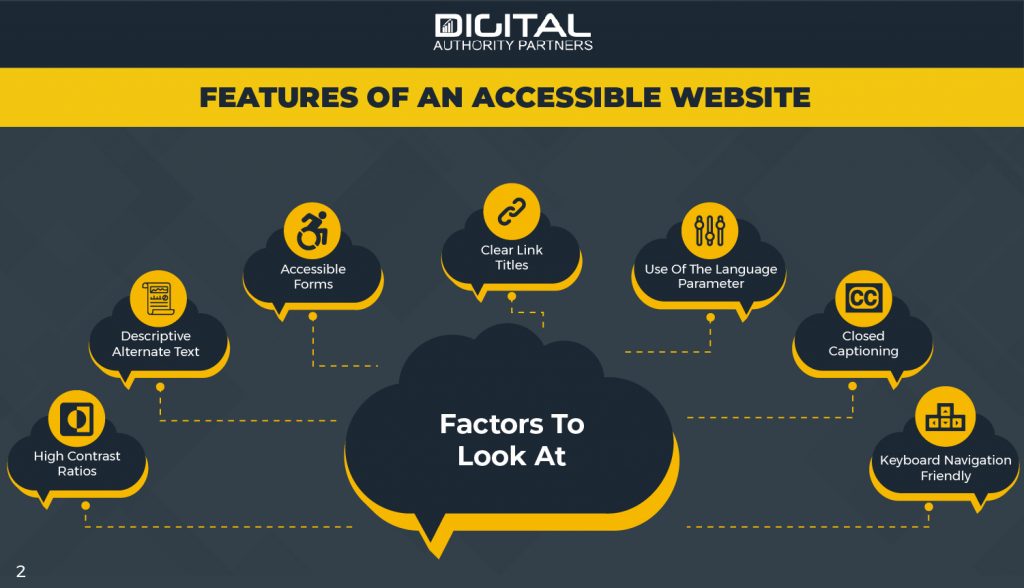
Many owners and managers of hotels and event venues understand accessibility ramps, wheelchair elevators, accessible restrooms, and accessible ingress and egress doors.
But what about their website, reservation system, mobile app, or other digital products? What exactly makes a website “accessible”?
WCAG 2.1

A short answer to that question lies in compliance with Web Content Accessibility Guidelines 2.1 (WCAG 2.1), the standard in most states for digital accessibility and ADA compliance.
Promulgated by the World Wide Web Consortium (W3C) and drafted by the W3 Accessibility Guidelines Working Group, WCAG 2.1 lays out criteria and guidelines for accessible websites. Most of these guidelines are geared toward accommodations for key disabilities that might hinder someone’s ability to access critical content or functionality. These include:
- Blindness or Vision Impairment—unable to see or read visible content.
- Deafness or Hearing Loss—unable to hear audio content.
- Motor Impairment—unable to navigate the website without the use of fine motor skills like “point and click,” which may be limited due to motor impairments.
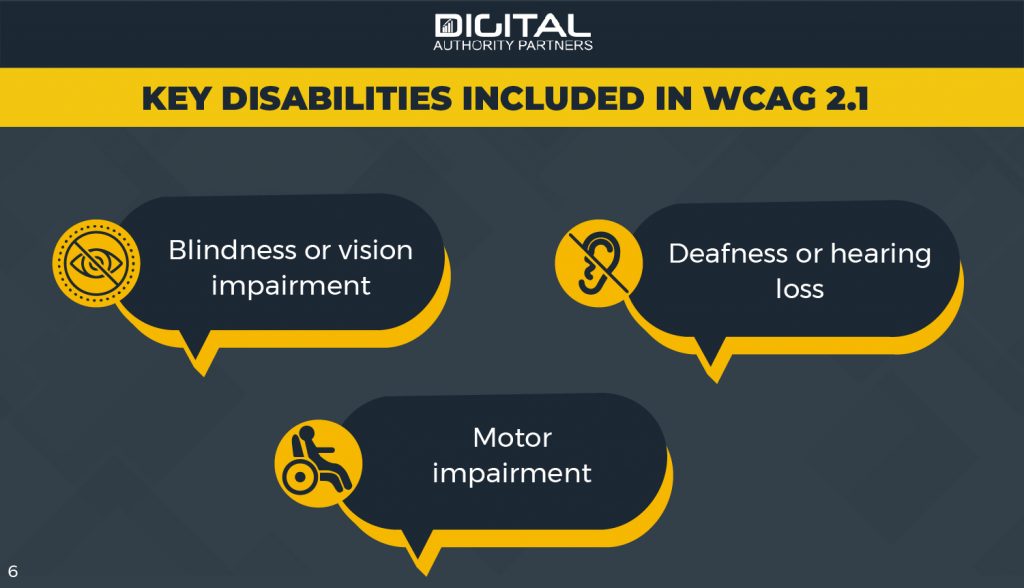
As of August 2020, a draft of WCAG 2.2 is available for public review, with comments due by September 2020. Until it is finalized, WCAG 2.1 remains the standard. But what are some of the specifics of WCAG that impact business’ digital reach to consumers?
Contrast Ratios
Contrast refers to the difference between the color of text and the background color. With too little contrast, web content may be unreadable by people with impaired vision.
Certain color pairings, additionally, may make it impossible for people with colorblindness to read the text. For example, green text against a red background may be perfectly readable to people with unimpaired vision, even if the colors are a similar shade. However, to a colorblind person, the same website might look like a blank, uniformly gray screen, completely unreadable.
WCAG 2.1 guidelines recommend a contrast ratio of at least 4.5:1 for basic body text. This means that the text should be at least 4.5 shades darker than the background, or vice versa. For large text, like titles or headers, a contrast of at least 3:1 is recommended.
Alt Text
Alternate text, sometimes shortened to alt text, is text that forms part of the metadata of an image file. Most viewers of a website will never see the alternate text, but it is there in the coding. Web developers often load alt text with keywords for search engine optimization purposes.
Alt text serves another important function. Legally blind persons might use a screen reader to browse the web. This application reads the text on a website aloud to the browser from a speaker, converting the site’s User Experience (UX) into an entirely auditory experience.
Screen readers can easily read text, but they can’t describe images -- unless the web developer has included descriptive alt text in the image coding.
An inattentive developer might include the alt text “Amenities 1” in an image of the hotel pool. This doesn’t tell a blind person much if that’s all the screen reader tells them. A better alt text tag might read “Rooftop infinity pool with chaise lounges, private cabana seating by reservation, and poolside bar serving tropical drinks.”
Accessible Forms
Most venue and hotel reservation systems require the filling out of online forms. Web forms may also make up other key functions of the hotel or venue’s website, like complaint forms and feedback forms. They are a key part of accessing additional information or engaging with the business--and these forms are an often overlooked vector of website inaccessibility.
Once again, the key demographic is visually-impaired. A key function of most forms are required fields, usually marked with a red star. If the user fails to fill out the required fields or fills them incorrectly, the form cannot be submitted.
Many websites have default form-requirement blockers. The submission will return a generic “Error” message and highlight the offending form field in red.
This is useless to a user with colorblindness or who’s using a screen reader. A screen reader can’t tell the user which field is highlighted in red; colorblindness might prevent the user from seeing which field is highlighted in red.
To comply with ADA, the error message must identify the offending field, preferably with a notification directly above the field itself, which screen readers can read aloud and which people with colorblindness can see. Again, attention must be paid to text contrast.
Link Titles
Most hotel or venue websites have multiple pages, which users must navigate through the use of hyperlinks. Hyperlinks usually have anchor text—text you click on to activate the hyperlink, usually identified by blue font color and underlined. Hyperlinks can also be images, like buttons.
To comply with ADA, the hyperlink anchor text must clearly identify the link and describe where the link leads. If a screen reader identifies a link as “Click Here,” that tells the user nothing. However, if the screen reader identifies the link anchor text as “Click Here to Learn More About Our Loyalty Program and its Perks,” that tells the user a lot more. They can effectively navigate the site with anchor text that is that descriptive.
Don’t forget about alt text. If hyperlinks are anchored to images, the image alt text should be equally descriptive.
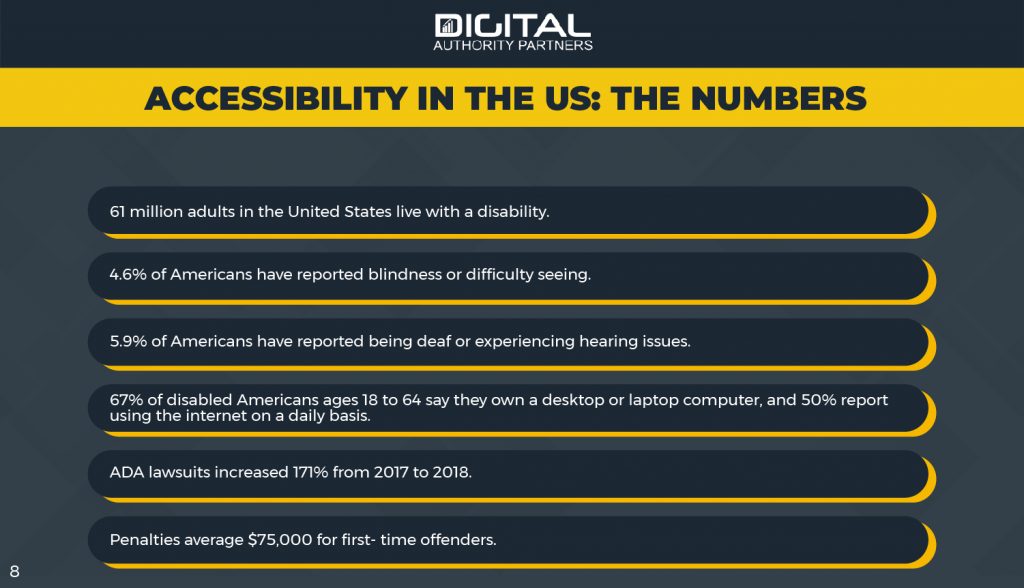
Language Parameter
A key function of screen readers is that they must be able to identify what language the content is written in. HTML has a “Lang” attribute that gives web developers and coders the opportunity to identify the language of the content to be included.
The “Lang” attribute does not affect the appearance of the site. If it is forgotten or omitted, many people may not even realize it. But a blind person attempting to use a screen reader to browse the site will discover it immediately when the screen reader announces that it can’t identify the language of the site.
Closed Captioning
Closed captioning has been the standard for many years to adapt video content for the hearing-impaired. To comply with ADA, any video content found on the site should be armed with closed captioning so deaf users can read the video content from captions.
Keyboard Navigation

Many websites are built around “point-and-click” functions to be operated with a mouse or trackpad. However, the fine motor skills to point and click may not be available to people with motor-impairment disabilities.
To comply with ADA, all critical functions of the website, including navigating links, forms, and dropdown menus, must be accessible using keyboard functions like the “Tab” key.
[bctt tweet="Penalties assessed against ADA violators average $75,000 for a first offense." via="no"]
Three ADA Compliance Issues Hotels and Venues Should Monitor
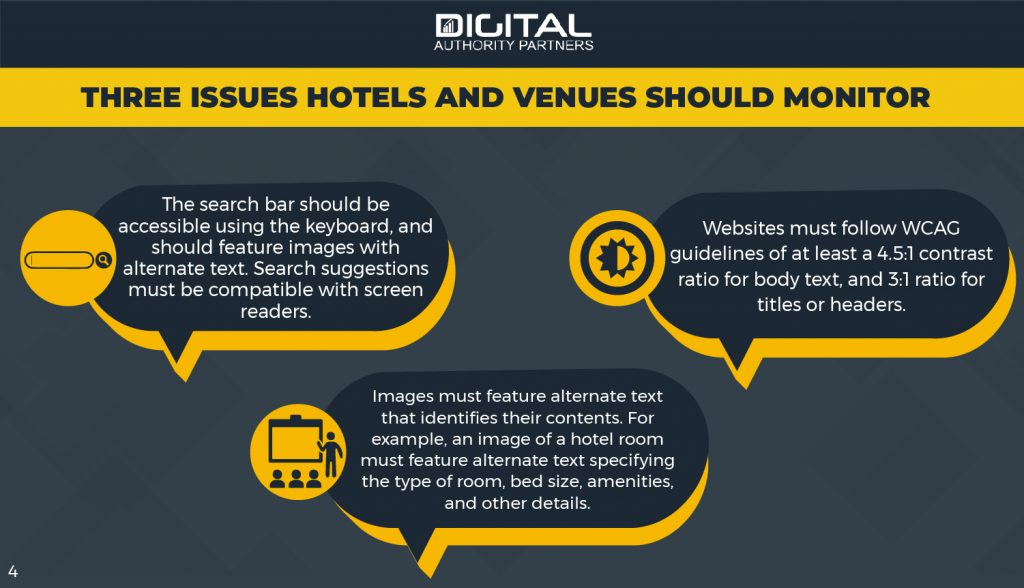
The above list is a starting point, an illustrative but incomplete breakdown of potential problem areas that companies should address to protect themselves from ADA lawsuits and provide the best possible service to their customers with disabilities.
Areas of particular concern to hotels or event venues include:
Search Bar
Many hotel or venue websites offer internal search functions to help users navigate sprawling websites. Make sure that:
- The search bar can be accessed by keyboard alone.
- Identifying images like a magnifying glass icon have descriptive alt text, like “Search” or “Search Bar.”
- Make sure that the focus of the data input remains on the search bar, even as the user tabs through suggested results. The user should be able to continue to input or modify data in the search bar, without getting stuck on search term suggestions.
- Search suggestions must be compatible with screen readers.
- Consider adding a skip link to the search function to simplify the feature for disabled persons using keyboards or screen readers.
Contrast
Hotel and event venue websites convey important information in writing. Developers for these companies must pay close attention to the color contrast of the text content, following WCAG guidelines of at least 4.5:1 contrast ratio for body text and at least 3:1 contrast ratio for title or header text.
Images
Images also form an important part of the brand story for hotels and event venues. Image alt text should be scrupulously descriptive, identifying the image contents in detail, including:
- Specifics of depicted rooms (king, queen, suite, etc.)
- Descriptions of depicted views (ocean, forest, skyline, etc.)
- Specifics of depicted facilities (capacity, allowed uses, etc.)
- Specifics of depicted amenities (pool, gym, dining room, etc.)
- Specifics of depicted services (catering, AV, security, etc.)
How Hotels and Venues Can Become Fully ADA Compliant
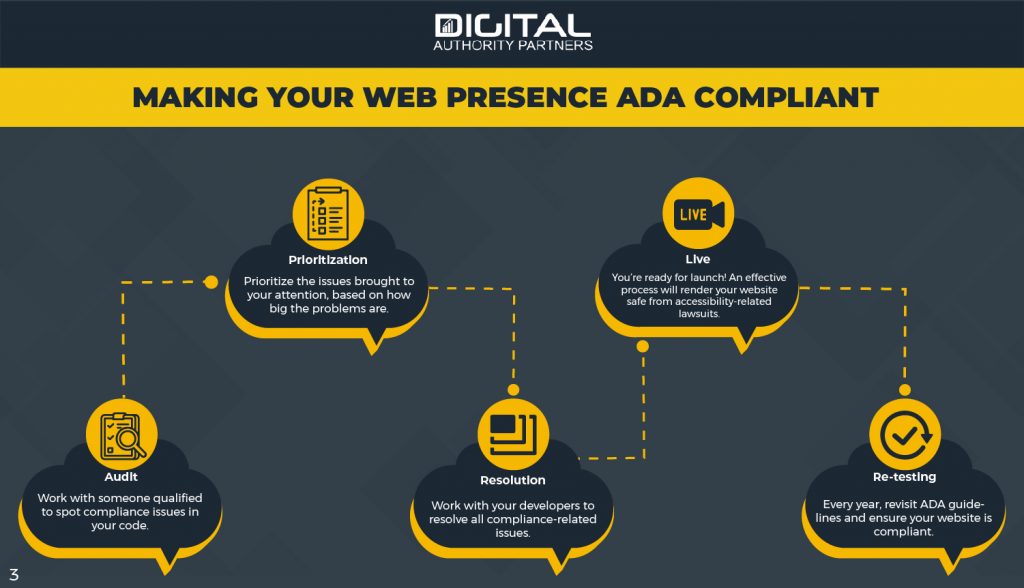
The rise in ADA compliance litigation, as well as judicial rulings favorable to the plaintiffs in these lawsuits, underlines the importance of hotels and event venues in getting their websites in order sooner rather than later.
Here are some basic steps to kick off the process of bringing your web assets into compliance:
Audit Of Your Website

The first step is to figure out where your website falls short. Every website could stand to tighten its ADA compliance to guard against litigation, and some sites are in desperate need of an ADA update.
An ADA audit will require that someone inspect your website at the code level and that someone has to be qualified to spot ADA compliance issues. Most organizations don’t have someone in-house who is qualified to do this, so it is usually valuable to partner with a third-party agency that specializes in accessible websites.
Prioritize the Issues
If your ADA auditor is doing his/her job, (s)he will emerge from the audit with a laundry list of liabilities in your website, hiding in plain sight or not hiding at all.
The next task is to create a priority list, with the biggest liabilities on top. This will vary from site to site, but for a hotel or event venue, the top offenders to look at will probably include:
- Non-compliant search bars
- Insufficient color contrast for text
- Inaccessible forms
- Lack of descriptive image alt text
- Lack of descriptive link text
Any one of these could be pointed to in a lawsuit as signs of non-compliance.
Start Resolving Them
Once you have your to-do list, it’s time to start fixing them. This will mostly be done at the code level. Your web development or IT may need to partner with a third-party company that specializes in compliance in order to execute all the necessary changes.
Put Them Into Production
Once all the fixes are coded, launch the doctored website with the changes live.
Re-Test All the Issues
Now that the changes are live, retrace the steps of the audit and test every issue again. The modified website should be navigable by keyboard only, have adequate color contrast, closed-captioning on all video content, and interact seamlessly with screen readers, including language tagging, descriptive alt text, and descriptive links.
Every Year, Test Again
Accessible web design is not one-and-done. The ADA compliant components of your website should be tested every year to make sure they are still functional and haven’t become corrupted. Updates to WCAG may also necessitate new changes to comply with new standards. Given the potential cost of ADA litigation, it pays to be vigilant about the ADA compliance of your web experiences.
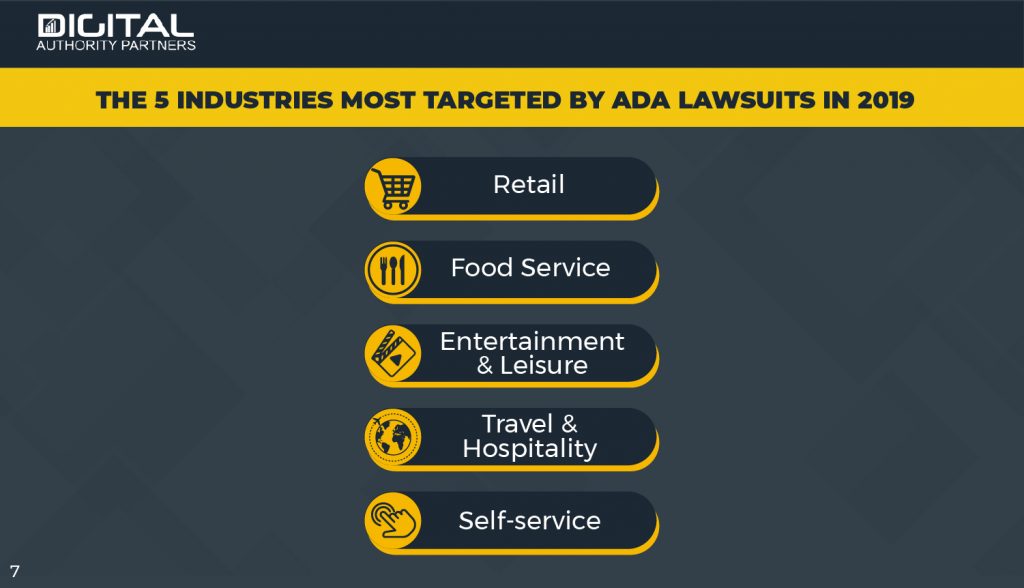
Conclusion
If there was any doubt about a hotel or event venue owner’s responsibility to offer accessible websites, apps, and digital experiences, that doubt was put to rest with the 2012 DOJ ruling and subsequent Federal court rulings.
Ramps and automatic doors are no longer enough. ADA litigation has increased greatly even from recent years, and hotels and event venues are in the crosshairs—sometimes in the crosshairs of “frequent litigators” who successfully bring suits in out-of-state courts.
For a hotel or venue owner who values their customer experience (and their bottom line), it’s a time to be proactive. These entrepreneurs shouldn’t wait for a lawsuit to fall out of the sky. The cost of updating their web experiences to comply with ADA is more than justified by the risk-reduction value. And as an added bonus, they can do their part in realizing one of the great civil rights breakthroughs of the last century.
If you’re interested in learning more about how to update your website to comply with ADA, don’t hesitate to get in touch!
Want To Meet Our Expert Team?
Book a meeting directly here

